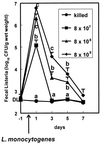Quantifying translocation of Listeria monocytogenes in rats by using urinary nitric oxide-derived metabolites
- PMID: 11097905
- PMCID: PMC92459
- DOI: 10.1128/AEM.66.12.5301-5305.2000
Quantifying translocation of Listeria monocytogenes in rats by using urinary nitric oxide-derived metabolites
Abstract
The urinary nitric oxide metabolites NO(2)(-) and NO(3)(-) (summed as NO(x)) are a noninvasive, quantitative biomarker of translocation of salmonella from the intestinal lumen to systemic organs. Listeria monocytogenes is a food-borne gram-positive pathogen that can also cross the intestinal epithelium. In this study, we tested the efficacy of urinary NO(x) as a marker of listeria translocation. Rats (eight per group) were orally infected with increasing doses of L. monocytogenes; control rats received heat-killed listeria. The kinetics of urinary NO(x) and population levels of listeria in feces were determined for 7 days. Another group of rats was killed 1 day after infection to verify translocation by culturing viable listeria from systemic organs. Oral administration of increasing doses of L. monocytogenes resulted in a time- and dose-dependent increase in urinary NO(x) excretion. Translocation was a prerequisite for inducing a NO(x) response, since heat-killed L. monocytogenes did not elevate NO(x) excretion in urine. Fecal counts of listeria also showed dose and time dependency. Moreover, the number of viable L. monocytogenes cells in mesenteric lymph nodes also increased in a dose-dependent manner and correlated with urinary NO(x). In conclusion, urinary NO(x) is a quantitative, noninvasive biomarker of listeria translocation.
Figures



Similar articles
-
Nitric oxide-derived urinary nitrate as a marker of intestinal bacterial translocation in rats.Gastroenterology. 1994 Jul;107(1):47-53. doi: 10.1016/0016-5085(94)90059-0. Gastroenterology. 1994. PMID: 8020688
-
Dietary calcium inhibits the intestinal colonization and translocation of Salmonella in rats.Gastroenterology. 1997 Aug;113(2):550-7. doi: 10.1053/gast.1997.v113.pm9247475. Gastroenterology. 1997. PMID: 9247475
-
Sweet buttermilk intake reduces colonisation and translocation of Listeria monocytogenes in rats by inhibiting mucosal pathogen adherence.Br J Nutr. 2012 Dec 14;108(11):2026-33. doi: 10.1017/S0007114512000165. Epub 2012 Feb 27. Br J Nutr. 2012. PMID: 22370235
-
Listeria monocytogenes: a causative agent of gastroenteritis?Eur J Clin Microbiol Infect Dis. 2001 Jun;20(6):369-73. doi: 10.1007/pl00011277. Eur J Clin Microbiol Infect Dis. 2001. PMID: 11476434 Review.
-
Listeria as an enteroinvasive gastrointestinal pathogen.Curr Top Microbiol Immunol. 2009;337:173-95. doi: 10.1007/978-3-642-01846-6_6. Curr Top Microbiol Immunol. 2009. PMID: 19812983 Review.
Cited by
-
Dietary fructo-oligosaccharides and inulin decrease resistance of rats to salmonella: protective role of calcium.Gut. 2004 Apr;53(4):530-5. doi: 10.1136/gut.2003.023499. Gut. 2004. PMID: 15016747 Free PMC article.
-
Dietary fructo-oligosaccharides and lactulose inhibit intestinal colonisation but stimulate translocation of salmonella in rats.Gut. 2003 Nov;52(11):1572-8. doi: 10.1136/gut.52.11.1572. Gut. 2003. PMID: 14570725 Free PMC article.
References
-
- Ahren C, Jungersten L, Sandberg T. Plasma nitrate as an index of nitric oxide formation in patients with acute infectious diseases. Scand J Infect Dis. 1999;31:405–407. - PubMed
-
- Aureli P, Fiorucci G C, Caroli D, Marchiaro G, Novara O, Leone L, Salmaso S. An outbreak of febrile gastroenteritis associated with corn contaminated by Listeria monocytogenes. N Engl J Med. 2000;234:1236–1241. - PubMed
MeSH terms
Substances
LinkOut - more resources
Full Text Sources

